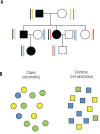Assessing the genetic risk for alcohol use disorders
- PMID: 23134042
- PMCID: PMC3860406
Assessing the genetic risk for alcohol use disorders
Abstract
The past two decades have witnessed a revolution in the field of genetics which has led to a rapid evolution in the tools and techniques available for mapping genes that contribute to genetically complex disorders such as alcohol dependence. Research in humans and in animal models of human disease has provided important new information. Among the most commonly applied approaches used in human studies are family studies, case-control studies, and genome-wide association studies. Animal models have been aimed at identifying genetic regions or individual genes involved in different aspects of alcoholism, using such approaches as quantitative trait locus analysis, genome sequencing, knockout animals, and other sophisticated molecular genetic techniques. All of these approaches have led to the identification of several genes that seem to influence the risk for alcohol dependence, which are being further analyzed. Newer studies, however, also are attempting to look at the genetic basis of alcoholism at the level of the entire genome, moving beyond the study of individual genes toward analyses of gene interactions and gene networks in the development of this devastating disease.
Figures

Similar articles
-
Identifying gene networks underlying the neurobiology of ethanol and alcoholism.Alcohol Res. 2012;34(3):306-17. Alcohol Res. 2012. PMID: 23134046 Free PMC article.
-
Genetic research: who is at risk for alcoholism.Alcohol Res Health. 2010;33(1-2):64-75. Alcohol Res Health. 2010. PMID: 23579937 Free PMC article.
-
The genetic basis of alcoholism: multiple phenotypes, many genes, complex networks.Genome Biol. 2012 Feb 20;13(2):239. doi: 10.1186/gb-2012-13-2-239. Genome Biol. 2012. PMID: 22348705 Free PMC article. Review.
-
Integrative Analysis of Genetic, Genomic, and Phenotypic Data for Ethanol Behaviors: A Network-Based Pipeline for Identifying Mechanisms and Potential Drug Targets.Methods Mol Biol. 2017;1488:531-549. doi: 10.1007/978-1-4939-6427-7_26. Methods Mol Biol. 2017. PMID: 27933543 Free PMC article.
-
Genetic studies of alcohol dependence in the context of the addiction cycle.Neuropharmacology. 2017 Aug 1;122:3-21. doi: 10.1016/j.neuropharm.2017.01.017. Epub 2017 Jan 22. Neuropharmacology. 2017. PMID: 28118990 Free PMC article. Review.
Cited by
-
Recent Efforts to Dissect the Genetic Basis of Alcohol Use and Abuse.Biol Psychiatry. 2020 Apr 1;87(7):609-618. doi: 10.1016/j.biopsych.2019.09.011. Epub 2019 Sep 25. Biol Psychiatry. 2020. PMID: 31733789 Free PMC article. Review.
-
Alcohol Use Disorder and Associated Factors Among Jimma University Undergraduate Students.Psychol Res Behav Manag. 2020 Jul 27;13:609-618. doi: 10.2147/PRBM.S251510. eCollection 2020. Psychol Res Behav Manag. 2020. PMID: 32801958 Free PMC article.
-
Proteomic approaches and identification of novel therapeutic targets for alcoholism.Neuropsychopharmacology. 2014 Jan;39(1):104-30. doi: 10.1038/npp.2013.182. Epub 2013 Jul 31. Neuropsychopharmacology. 2014. PMID: 23900301 Free PMC article. Review.
References
-
- Crabbe JC, Phillips TJ, Harris RA, et al. Alcohol-related genes: Contributions from studies with genetically engineered mice. Addiction Biology. 2006;11(3–4):195–269. - PubMed
-
- Edenberg HJ, Foroud T. The genetics of alcoholism: Identifying specific genes through family studies. Addiction Biology. 2006;11(3–4):386–396. - PubMed
-
- Foroud T, Edenberg HJ, Goate A, et al. Alcoholism susceptibility loci: Confirmation studies in a replicate sample and further mapping. Alcoholism: Clinical and Experimental Research. 2000;24(7):933–945. - PubMed
Publication types
MeSH terms
Substances
Grants and funding
LinkOut - more resources
Full Text Sources
Medical
Miscellaneous

